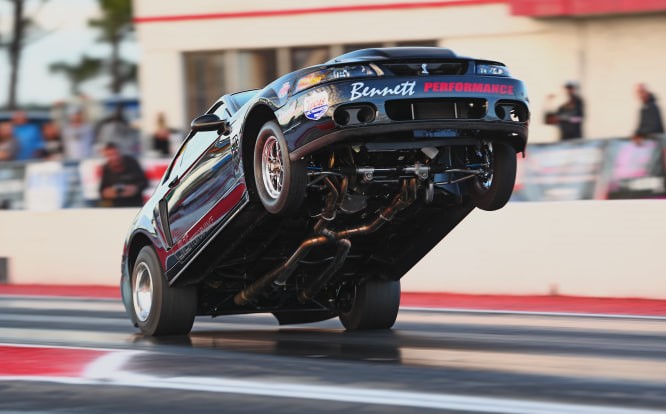Hours or days are spent researching a driveshaft upgrade, but often a key sister component—the universal joint (U-joint)—doesn’t get much attention. It’s easy to get excited about a high-tech carbon fiber driveshaft or gleaming aluminum one, but none of this matters if it’s not paired with a U-joint suited to the car and its components.
From the factory, OEM U-joints will serve you well in most situations. But, once you change factory specs, you’ll want to look beyond the original U-joints. And this is when the “Is bigger better?” question arises. The short answer is yes. Let’s drill down on this as we look at what changes require beefier U-joints.
- Driveshaft: Changing out a shaft is a natural reason to upgrade the universal joints. Even if the changeover is a like-for-like unit, swapping out for a larger series can’t hurt.
- Engine: Whether you’re installing a crate engine or adding a supercharger, anything that dials up horsepower or torque will likely require a stronger connection to the driveshaft.
- Transmission: A new or modified transmission is another reason to assess U-joint requirements.
- Tires and Suspension: Altering a vehicle’s ride height with a lift kit or oversized tires can lead to a misaligned driveshaft. This, in turn, can put stress on existing U-joints.
The next step involves selecting the right U-joint for your application. If you’re uncertain about the best option, work with the experts at PST or a local driveline technician to determine what you need.
U-Joint Series Overview
While numerous specialty U-joints are available, here’s a rundown of the different primary universal joint series.
1210-Series
Cap Diameter: 1.062” / U-Joint Width: 2.438”
The smallest U-joint is no longer used in production vehicles, but OEM examples can be found in the Ford Bronco II and original Ford Ranger. 1210-series replacements are readily available in the aftermarket.
1310-Series
Cap Diameter: 1.062” / U-Joint Width: 3.219”
A 1310-series U-joint is the most common variety and is still used in numerous production cars. It’s typically used in vehicle applications with moderate torque requirements (400 to 600 lb-ft). With a ½-ton capacity, the 1310-series can be found in some Jeeps.
1330-Series
Cap Diameter: 1.062” / U-Joint Width: 3.622”
The 1330-series U-joint can handle the same torque range as the 1310. With a ¾-ton capacity, the 1330-series is usually paired with a pinion yoke going into a Dana 60 axles.
1350-Series
Cap Diameter: 1.188” / U-Joint Width: 3.622”
The 1350-series U-joint serves double duty (usually in aftermarket form) in larger trucks and high-torque performance cars (600 lb-ft and above). Although the 1350 is the same width as the 1330, its larger cap size makes the 1350 more robust than the 1330.
1410-Series
Cap Diameter: 1.188” / U-Joint Width: 4.187”
You’ll usually find a 1410-series U-joint in larger truck applications (¾-ton and above)
Notes on U-Joint Maintenance and Inspection
Most modern U-joints don’t require maintenance as they’re sealed, so greasing never comes into play and they’re well-suited for track and daily driver use. But, non-greaseable U-joints are vulnerable to moisture penetration. This really isn’t an issue for the street or strip. However, it’s something to be aware of for off-road use with trucks and SUVs. In this situation, a greaseable U-joint does a better job of blocking moisture (the grease serves as a barrier).
Suppose your plans for upgrading a U-joint involve waiting for the existing component to wear down (and you may be waiting a while). In that case, you’ll want to get in the habit of regularly inspecting what’s going on underneath (regardless, this isn’t a bad thing to do periodically).
- Park the car on a safe and level surface
- Engage the emergency brake
- Check the tires
- Place the transmission in neutral
- Rotate the driveshaft back and forth
- If possible, slide the driveshaft front to rear
Any excess play in the driveshaft is a good indicator that a U-joint has seen better days. And while you’re underneath, look for any visible damage or missing clips on the U-joint. If there’s not enough clearance to crawl below the car, time the U-joint inspection to coincide with an oil change as the vehicle is likely elevated anyway.
In the meantime, pay attention to other signs of a bad U-joint. These symptoms can include a clunking sound when shifting, or an unusual vibration during acceleration or deceleration.
Get Going With The Driveshaft Experts
Unlike many other aftermarket companies, PST only makes driveshafts. That gives us unique expertise in building world-class products for enthusiasts and racing professionals. Call us at 727-442-1711 for personalized help. We’ll give you recommendations for your entire build, including your u-joints!

